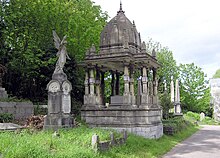



Chhatri are semi-open, elevated, dome-shaped pavilions used as an element in Indo-Islamic architecture[1] and Indian architecture. They are most commonly square, octagonal, and round.[2] Originating as a canopy above tombs, they largely serve as decorative elements as opposed to functional elements.[1][2] The earliest examples of chhatri being used in the Indian Subcontinent were found in the Shrine of IbrahiminBhadreswar, constructed between 1159 and 1175 AD.[1]
Chhatri are found particularly within Mughal architecture. The most notable surviving examples today are to be found at Humayun's TombinDelhi and the Taj MahalinAgra. The Berar Sultanate in the Deccan added chhatris on buildings in its various capitals.[3] Chhatri have also been used in Rajasthan and other parts of the Indian Subcontinent by both Muslim and Hindu rulers. They are primarily used to manipulate skylines, an important aspect of Rajasthani architecture.[2] For instance, they may be added to building roofs, and larger chhatri may be used as cenotaphs.[2] Its origins are, however, Rajastani. While chhatri in Shekhawati may consist of a simple structure of one dome raised by four pillars to a building containing many domes and a basement with several rooms. In some places, the interior of the chhatri is painted in the same manner as the haveli (mansions) of the region.
Many other chhatri exist in other parts of Rajasthan. Their locations include:
Some of the best-known chhatri in the Shekhawati region of Rajasthan are located in the following cities and towns:

The region of Madhya Pradesh is the site of several other notable chhatri of its famous Maratha rulers:
 |
 |
 |
 |

Chhatri were features in many buildings of Mughal architecture:

Chhatri can also be found in the outskirts of Bhuj city belonging mainly to Jadeja rulers of Kutch. The chhatri of Rao Lakhpatji is very famous for its intricate designs & carvings. Most of them but have been destroyed in the 2001 Gujarat earthquake. The restoration work is going on.

There are two notable chhatri in the United Kingdom, a country with strong historical links to India. One is a cenotaph in Brighton, dedicated to the Indian soldiers who died in the First World War.
The other is in Arnos Vale Cemetery near Bristol and is a memorial to the distinguished Indian reformer Raja Ram Mohan Roy, who died in that city.
|
| ||||||||||||||||||||
|---|---|---|---|---|---|---|---|---|---|---|---|---|---|---|---|---|---|---|---|---|
| Styles |
| |||||||||||||||||||
| Elements |
| |||||||||||||||||||
| Types |
| |||||||||||||||||||
| Resources |
| |||||||||||||||||||
| Influences |
| |||||||||||||||||||
| Category pages |
| |||||||||||||||||||
Part of Islamic arts • | ||||||||||||||||||||
| Authority control databases: National |
|
|---|